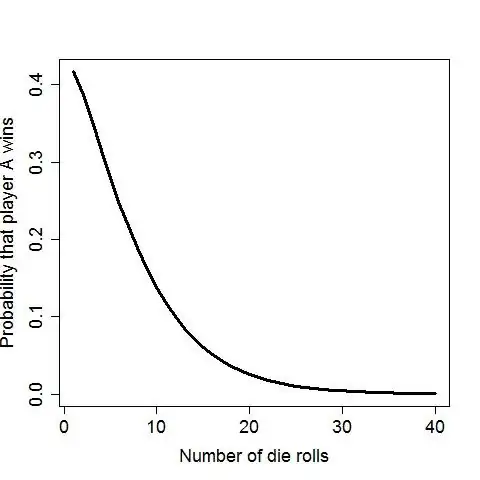$A$ and $B$ play a dice game where a player wins if their score is higher. $B$ wins if their score is equal. What is the probability of $A$ winning if both the players roll their dice $n$ times and choose their best scores (out of their $n$ throws)?
-
5The main task here is to derive the distribution of the maximum. Here's a hint: If $M=\max \{X_1, ..., X_n\}$, then $$ P(M \leq x) = P(X_1 \leq x, ..., X_n \leq x) $$ If the $X$s are independent, as they seem to be here, this calculation is straightforward. Then, you have two independent realizations, $M_A, M_B$ and you can calculate $P(M_A > M_B)$. BTW, in this example, it's intuitive that the probability of A winning quickly goes to zero as $n$ increases since their maximums become increasingly likely to both be six, in which case B wins. – Macro Aug 23 '13 at 14:14
-
Can you explain the above concept using a simpler example ? – rudrick ross Aug 23 '13 at 14:33
-
2Consider a two-sided die with values $0$ and $1$ on its faces, to be thrown $n=2$ times. For either player, the chance of getting two or fewer $1$'s is $1$ while the chance of getting all $0$'s is $1/2\times 1/2=1/4$. Therefore the chance that the highest throw will equal $1$ is the difference $1-1/4=3/4$ and the chance the highest will equal $0$ is $1/4$. When A and B both throw, there is a $1/4\times 1/4=1/16$ chance they tie at $0$ and $3/4\times 3/4=9/16$ chance they tie at $1$, for a total chance of $5/8$ of tying. They *don't* tie $3/8$ of the time and A wins in half of those: $3/16$. – whuber Aug 23 '13 at 18:39
-
[related](http://stats.stackexchange.com/questions/1424/the-risk-game-dice-problem) – Glen_b Feb 18 '14 at 06:17
1 Answers
For a particular die roll the cumulative probability is $ P(X_i \leq x ) = x/6 $, for $x=1,...,6$. So, if the die rolls are independent,
$$ P(\max \{ X_1, ..., X_n \} \leq m) = P(X_1 \leq m, ..., X_n \leq m) = \prod_{i=1}^{n} P(X_i \leq m ) = \left( \frac{m}{6} \right)^n $$
for $m=1,...,6$. When $m > 6$ this probability is clearly $1$ and $0$ if $m < 1$.
From this it's simple to deduce that $$P(\max \{ X_1, ..., X_n \} = m) = \frac{m^n - (m-1)^n}{6^n} $$
(I've suppressed the indicator that $m \in \{1,...,6\}$). Note that to generalize this to a $k$-sided die, just replace $6$ everywhere with $k$.
Suppose players $A$ and $B$ throw the die $n_A$,$n_B$ times with maximum rolls $M_A, M_B$, respectively. By the description above, player $A$ wins if $M_A > M_B$. Using the law of total probability,
\begin{align*} P(M_A > M_B) &= E_{m} \Big( P(M_A > M_B | M_B = m) \Big) \\ &= E_{m} \Big(1 - \Big( \frac{m}{6} \Big)^{n_A} \Big) \\ &= \frac{1}{6^{n_A + n_B}} \sum_{m=1}^{6} \left(6^{n_A} - m^{n_A} \right) \left(m^{n_B} - (m-1)^{n_B} \right) \end{align*}
If $n_A = n_B = n$, this simplifies to
$$ \frac{1}{6^{2n}}\sum_{m=1}^{6} \left(6^n - m^n \right) \left(m^n - (m-1)^n \right) $$
Below this is plotted as a function of $n$. In this example, it's intuitive that the probability of $A$ winning quickly goes to zero as $n$ increases since their maximums become increasingly likely to both be six, in which case $B$ wins.
$ \ \ \ \ \ \ \ \ \ \ \ \ \ \ \ \ $
- 40,561
- 8
- 143
- 148
-
5+1 This analysis and its results generalize to $k$-sided dice (such as $k$=2, a "fair coin") with only trivial changes. An alternative formula for the answer can be obtained by noting that A's probability of winning is just one-half the chance a tie does not occur and then finding the chance that a tie *does* occur. – whuber Aug 23 '13 at 18:00
-
2Yes @whuber (+1). I think it would suffice to just replace $6$ everywhere with $k$. – Macro Aug 23 '13 at 19:26
-
What if we now consider A and B throwing the dice multiple times but not the same number of times ? – rudrick ross Aug 23 '13 at 20:21